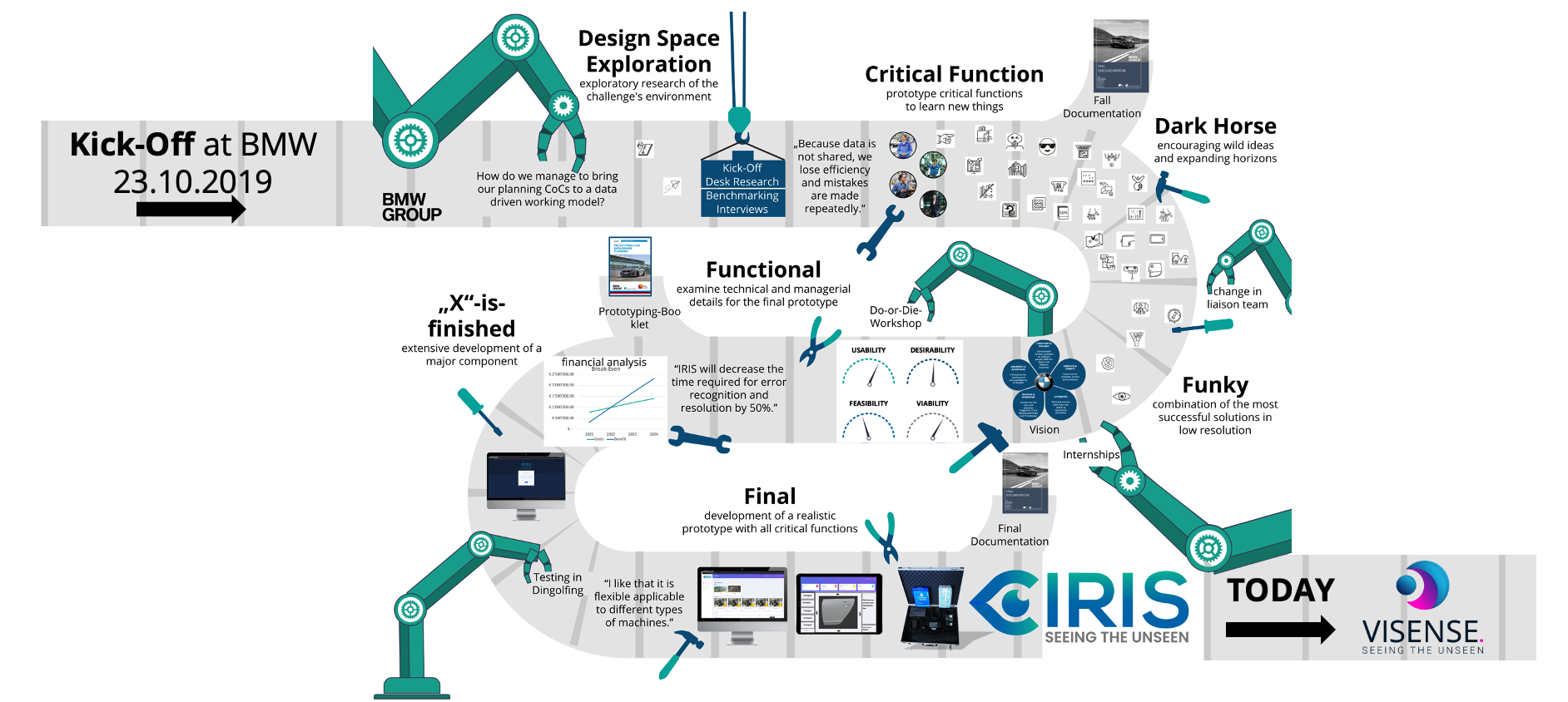The value of Design Thinking in solving complex problems for industrial manufacturing
Design Thinking as an approach for wicked problem solving and the development of innovative ideas is spreading in organizations throughout the world. What is it about, how does it work, and what are the potential benefits of applying Design Thinking? Showcasing VISENSE, an industrial error monitoring start-up that emerged out of applying Design Thinking in an innovation project with the BMW Group can help you to understand how you can leverage the methodology for your company.
Design Thinking - Prototyping user-centered solutions
Deeply rooted in silicon valley, Tim Brown, CEO of IDEO, and Professor Larry Leifer, Director of the Center for Design Research at Stanford University, have coined the development of a problem-solving methodology that can help firms to develop breakthrough innovations. This is done by developing a deep understanding of the problem domain which serves as the foundation to develop a user-centered solution by iterative prototyping. But what is it actually about?
Design Thinking can be understood as a set of tools, a process, and a mindset (1). Inspired by the methods of designers, wicked problems are addressed through an iterative and visual way of working. In the beginning, interdisciplinary teams aim to deepen their problem understanding by interviewing important stakeholders and users. Having identified their needs through various synthesis techniques, low-resolution prototypes are quickly built and tested with users. Along this journey, teams get under the surface of the problem and can converge towards prototypes that match users’ needs, are viable for firms, and feasible for execution.
In terms of outcomes, firms can not only expect innovative solutions, but evidence also suggests that firms achieve customer proximity (2) and projects are faster in delivering tangible results.
Design Thinking in Manufacturing - VISENSE
The value of Design Thinking is illustrated by the case study of VISENSE, an industrial error monitoring start-up that was born out of a joint innovation project between business innovation and IT systems engineering graduates from Hasso Plattner Institute (HPI) and the University of St Gallen (HSG) collaborating with BMW Group.
Exploring the problem
The subject of the project concerned a challenge BMW Group provided around production planning processes. The initial task was to establish a data-driven working model. They leveraged Design Thinking techniques to thoroughly understand the problem at hand, which at its core lay with the processes around identifying and resolving machine errors. Many manufacturers today still have manual approaches to identifying errors and sharing information across the plant network. This not only leads to high costs and a loss of know-how but also to lower production quality and machine availability. This machine downtime is a massive and expensive problem for industrial manufacturers, causing average losses of 22’000 USD per minute (3).
Finding a solution for real industrial problems
As in every Design Thinking project a diversified project team was consciously composed. In this particular project, the focus was on selecting candidates to bring together IT and business expertise. Over nine-months the project team then moved through the different stages of the Design Thinking process (see illustration 1). During the first three Design Thinking phases - Design Space Exploration, Critical Function and Dark Horse - the project team systematically observed the problem space and diverged their knowledge over three months. This was done by applying different observation methodologies such as interviews, shadowing of the involved stakeholders and benchmarking other industries as well as creating personas, customer journeys, mind maps and using the 6-3-5 method. To put that in perspective over 60 Interviews were conducted and 15 different companies observed. Based on these findings, incremental prototypes were developed, continuously tested and the resulting insights iterated. In total, more than 30 prototypes were developed. Most of them emerged from the Darkhorse phase. During this phase it is about consciously daring, different and “crazy” ideas. Thereby, failing fast and often and learning from it was the decisive factor.
The following six months were all about converging knowledge. Within the upcoming phases - Funky, Functional, X-is finished and Final - the results were successively combined, summarized and partially abandoned to finally develop one final prototype.
Illustration 1: Design thinking journey over nine months
The result of this nine month Design Thinking journey is VISENSE, a data-driven solution that revolutionizes failure detection and analysis in mass production environments. VISENSE visualizes production error incidents through video data and enriches the data through sensor information and AI-driven data analytics. This allows machine experts to monitor machine performance and analyze error root causes at any time. Further, this information can then be easily shared in the VISENSE Dashboard with various stakeholders and within the entire BMW Group network.
This not only significantly reduces the need for machine experts to travel to remote locations within the plant network, but changes the entire operating processes on machine error handling. The systematic data-driven analysis and categorization of errors enable the machine experts to prevent repeat incidents from happening in the future and significantly accelerates ramp-up and handover of new machines. As a result, production quality is improved while increasing efficiency. The quick and non-intrusive set-up of the hardware allows VISENSE to be applied to a wide range of machine types within various industries. According to BMW Group, VISENSE has the potential to reduce time needed for machine error analysis by 50%. This makes a major contribution to increasing machine availability and subsequently reducing machine downtime.
Benefits & learnings of applying Design Thinking
Due to exceptionally positive feedback, the project was continued and a start-up was founded. Right now, the solution is in the process of being further developed and implemented within the BMW Group network. This prime example displays the great potential of the Design Thinking method to solve real problems. Key learnings out of this Design Thinking journey were that Design Thinking, in an industrial manufacturing environment, enables you to think beyond accustomed processes to create new innovative ideas. This is brought about by the structured design thinking framework and method, allowing and encouraging deliberate collaboration across departments, creativity, trial-and-error approaches, and most of all to learn from repeated, frequent failing. With that, the aim of Design Thinking is not to develop theoretical constructs, but to build tangible prototypes in order to test and improve them iteratively in a real environment.
The case study of VISENSE shows that the intense iterative approach allows to build up deep domain knowledge and understanding of the problem at hand within a timeframe that would be hard to achieve with conventional methods. Applying Design Thinking to complex problems may thus prove a valuable new strategy for industrial manufacturing companies in the future.
About the authors
Professor Dr. Falk Uebernickel holds the chair for Design Thinking and Innovation Research at the Hasso-Plattner-Institute (HPI), Germany's leading digital engineering faculty in Potsdam. Furthermore, he serves as a board member for the international university network Sugar, holds a professorship at the University of St Gallen and is co-founder of IT Management Partner St. Gallen AG (ITMP), an international management consultancy.
Thomas Haskamp is a Research Associate at the chair for Design Thinking and Innovation Research at HPI. Receiving a scholarship from the Foundation of German Business, he was educated in management and design thinking at the University of St Gallen and Rotterdam School of Management, Erasmus University. Right now, he is doing research on the interface of management, design thinking and digital innovation as a member of the Hasso Plattner Design Thinking Research program with Stanford University.
Pia Spori is co-founder and CEO of VISENSE. She currently studies in the master of Business Innovation at the University of St. Gallen, where she was part of the 2018/19 Design Thinking program led by Prof. Dr. Falk Uebernickel.
VISENSE
VISENSE provides a data-driven machine error monitoring solution for industrial manufacturing companies. If you are interested in learning more about our solution, please visit our website www.visense.io.
References
Uebernickel, Falk, and Walter Brenner. 2020. Design Thinking: The Handbook. World Scientific Publishing Company Pte Limited.
Vetterli, Christophe, Falk Uebernickel, Walter Brenner, Charles Petrie, and Dirk Stermann. 2016. “How Deutsche Bank’s IT Division Used Design Thinking to Achieve Customer Proximity.” MIS Quarterly Executive 15 (1).
Advanced Technology Services Inc., (ATS) – Survey of 101 Manufacturing Executives in the Automotive Industry, 2006.



